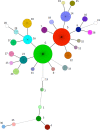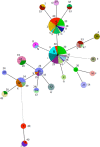Genetic structure of Mycobacterium avium subsp. paratuberculosis population in cattle herds in Quebec as revealed by using a combination of multilocus genomic analyses
- PMID: 24829229
- PMCID: PMC4136152
- DOI: 10.1128/JCM.00386-14
Genetic structure of Mycobacterium avium subsp. paratuberculosis population in cattle herds in Quebec as revealed by using a combination of multilocus genomic analyses
Abstract
Mycobacterium avium subsp. paratuberculosis is the etiological agent of paratuberculosis, a granulomatous enteritis affecting a wide range of domestic and wild ruminants worldwide. A variety of molecular typing tools are used to distinguish M. avium subsp. paratuberculosis strains, contributing to a better understanding of M. avium subsp. paratuberculosis epidemiology. In the present study, PCR-based typing methods, including mycobacterial interspersed repetitive units/variable-number tandem repeats (MIRU-VNTR) and small sequence repeats (SSR) in addition to IS1311 PCR-restriction enzyme analysis (PCR-REA), were used to investigate the genetic heterogeneity of 200 M. avium subsp. paratuberculosis strains from dairy herds located in the province of Quebec, Canada. The majority of strains were of the "cattle type," or type II, although 3 strains were of the "bison type." A total of 38 genotypes, including a novel one, were identified using a combination of 17 genetic markers, which generated a Simpson's index of genetic diversity of 0.876. Additional analyses revealed no differences in genetic diversity between environmental and individual strains. Of note, a spatial and spatiotemporal cluster was evidenced regarding the distribution of one of the most common genotypes. The population had an overall homogeneous genetic structure, although a few strains stemmed out of the consensus cluster, including the bison-type strains. The genetic structure of M. avium subsp. paratuberculosis populations within most herds suggested intraherd dissemination and microevolution, although evidence of interherd contamination was also revealed. The level of genetic diversity obtained by combining MIRU-VNTR and SSR markers shows a promising avenue for molecular epidemiology investigations of M. avium subsp. paratuberculosis transmission patterns.
Copyright © 2014, American Society for Microbiology. All Rights Reserved.
Figures




Similar articles
-
Genetic diversity of bovine Mycobacterium avium subsp. paratuberculosis discriminated by IS1311 PCR-REA, MIRU-VNTR, and MLSSR genotyping.J Vet Sci. 2018 Sep 30;19(5):627-634. doi: 10.4142/jvs.2018.19.5.627. J Vet Sci. 2018. PMID: 29929361 Free PMC article.
-
High genetic diversity among Mycobacterium avium subsp. paratuberculosis strains from German cattle herds shown by combination of IS900 restriction fragment length polymorphism analysis and mycobacterial interspersed repetitive unit-variable-number tandem-repeat typing.J Clin Microbiol. 2008 Mar;46(3):972-81. doi: 10.1128/JCM.01801-07. Epub 2008 Jan 3. J Clin Microbiol. 2008. PMID: 18174306 Free PMC article.
-
Suspicion of Mycobacterium avium subsp. paratuberculosis transmission between cattle and wild-living red deer (Cervus elaphus) by multitarget genotyping.Appl Environ Microbiol. 2012 Feb;78(4):1132-9. doi: 10.1128/AEM.06812-11. Epub 2011 Dec 16. Appl Environ Microbiol. 2012. PMID: 22179249 Free PMC article.
-
Current understanding of the genetic diversity of Mycobacterium avium subsp. paratuberculosis.Microbes Infect. 2006 Apr;8(5):1406-18. doi: 10.1016/j.micinf.2005.12.003. Epub 2006 Jan 26. Microbes Infect. 2006. PMID: 16697677 Review.
-
Molecular Epidemiology of Mycobacterium avium subsp. paratuberculosis on Dairy Farms.Annu Rev Anim Biosci. 2016;4:155-76. doi: 10.1146/annurev-animal-021815-111304. Epub 2015 Nov 2. Annu Rev Anim Biosci. 2016. PMID: 26526547 Review.
Cited by
-
Genotyping methods and molecular epidemiology of Mycobacterium avium subsp. paratuberculosis (MAP).Int J Vet Sci Med. 2018 Aug 7;6(2):258-264. doi: 10.1016/j.ijvsm.2018.08.001. eCollection 2018 Dec. Int J Vet Sci Med. 2018. PMID: 30564606 Free PMC article. Review.
-
Genetic diversity of bovine Mycobacterium avium subsp. paratuberculosis discriminated by IS1311 PCR-REA, MIRU-VNTR, and MLSSR genotyping.J Vet Sci. 2018 Sep 30;19(5):627-634. doi: 10.4142/jvs.2018.19.5.627. J Vet Sci. 2018. PMID: 29929361 Free PMC article.
-
Typing of Mycobacterium avium subspecies paratuberculosis isolates from Newfoundland using fragment analysis.PLoS One. 2015 Apr 30;10(4):e0126071. doi: 10.1371/journal.pone.0126071. eCollection 2015. PLoS One. 2015. PMID: 25927612 Free PMC article.
-
Evolutionary genomic and bacteria GWAS analysis of Mycobacterium avium subsp. paratuberculosis and dairy cattle Johne's disease phenotypes.Appl Environ Microbiol. 2021 Apr 15;87(8):e02570-20. doi: 10.1128/AEM.02570-20. Epub 2021 Feb 5. Appl Environ Microbiol. 2021. PMID: 33547057 Free PMC article.
-
Limitations of variable number of tandem repeat typing identified through whole genome sequencing of Mycobacterium avium subsp. paratuberculosis on a national and herd level.BMC Genomics. 2015 Mar 8;16(1):161. doi: 10.1186/s12864-015-1387-6. BMC Genomics. 2015. PMID: 25765045 Free PMC article.
References
-
- Johne HA, Frothingham J. 1895. Ein eigenthuemlicher Fall von Tuberculose beim Rind. Dtsch. Z. Tiermed. Pathol. 21:438–454
-
- Benedictus A, Mitchell RM, Linde-Widmann M, Sweeney R, Fyock T, Schukken YH, Whitlock RH. 2008. Transmission parameters of Mycobacterium avium subspecies paratuberculosis infections in a dairy herd going through a control program. Prev. Vet. Med. 83:215–227. 10.1016/j.prevetmed.2007.07.008 - DOI - PubMed
Publication types
MeSH terms
LinkOut - more resources
Full Text Sources
Other Literature Sources

